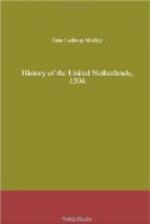The archduke came with rather a prejudice against the Spaniards— the result doubtless of his disappointment in regard to France—and he manifested at first an extreme haughtiness to those of that nation with whom he came in contact. A Castilian noble of high rank, having audience with him on one occasion, replaced his hat after salutation, as he had been accustomed to do—according to the manner of grandees of Spain— during the government of Farnese. The hat was rudely struck from his head by the archduke’s chamberlain, and he was himself ignominiously thrust out of the presence. At another time an interview was granted to two Spanish gentlemen who had business to transact. They made their appearance in magnificent national costume, splendidly embroidered in gold. After a brief hearing they were dismissed, with appointment of another audience for a few days later. When they again presented themselves they found the archduke with his court jester standing at his side, the buffoon being attired in a suit precisely similar to their own, which in the interval had been prepared by the court tailor.
Such amenities as these did not increase the popularity of Ernest with the high-spirited Spaniards, nor was it palatable to them that it should be proposed to supersede the old fighting Portuguese, Verdugo, as governor and commander-in-chief for the king in Friesland, by Frederic van den Berg, a renegade Netherlander, unworthy cousin of the Nassaus, who had never shown either military or administrative genius.
Nor did he succeed in conciliating the Flemings or the Germans by these measures. In truth he was, almost without his own knowledge, under the controlling influence of Fuentes, the most unscrupulous and dangerous Spaniard of them all, while his every proceeding was closely watched not only by Diego and Stephen Ybarra, but even by Christoval de Moura, one of Philip’s two secretaries of state who at this crisis made a visit to Brussels.




